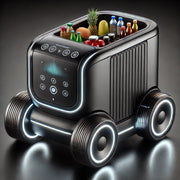In recent years, artificial intelligence (AI) and robotics have taken the world by storm, reshaping industries and redefining the boundaries of what is possible. From healthcare to agriculture, manufacturing to entertainment, the integration of these technologies is not just a trend; it's a seismic shift that promises to transform every field of human endeavour. This blog explores the profound impact of AI and robotics across various sectors, highlighting their potential benefits and the challenges they pose.
1. Healthcare: Precision and Efficiency
The healthcare industry has been one of the most significant beneficiaries of AI and robotics. Machine learning algorithms analyse vast amounts of medical data, assisting doctors in diagnosing diseases more accurately and at earlier stages. For example, AI can detect patterns in medical imaging that the human eye might miss, leading to timely interventions.
Robotics is revolutionizing surgery with minimally invasive techniques. Surgical robots enable surgeons to perform complex procedures with enhanced precision and control, resulting in quicker recovery times for patients. Additionally, robotic exoskeletons are aiding rehabilitation, allowing individuals with mobility impairments to regain independence.
2. Manufacturing: Automation and Innovation
The manufacturing sector has long been at the forefront of automation. With the rise of AI and robotics, this trend is accelerating. Smart factories equipped with AI-driven robots can monitor production processes in real-time, optimize workflows, and predict equipment failures before they occur. This not only increases efficiency but also reduces waste and lowers costs.
Moreover, collaborative robots, or "cobots," are designed to work alongside human workers, enhancing productivity and safety. This synergy allows for greater flexibility in production lines, accommodating the shift towards customized products without sacrificing efficiency.
3. Agriculture: Precision Farming
Agriculture is experiencing a technological renaissance thanks to AI and robotics. Precision farming utilizes AI algorithms to analyse soil health, weather patterns, and crop conditions, enabling farmers to make data-driven decisions. Drones equipped with sensors monitor crop health, while autonomous tractors and harvesters streamline labour-intensive tasks.
These innovations lead to increased crop yields, reduced resource consumption, and minimized environmental impact. By leveraging technology, farmers can sustain the growing global population while preserving the planet’s resources.
4. Transportation: The Future of Mobility
The transportation industry is on the brink of a revolution with the advent of AI and robotics. Self-driving cars promise to enhance road safety, reduce traffic congestion, and lower emissions. AI algorithms process data from numerous sensors to make real-time decisions, paving the way for a future where vehicles can communicate with each other and their environment.
Moreover, drones are emerging as a viable option for delivering goods, particularly in remote areas. This shift not only speeds up logistics but also opens up new opportunities for businesses to reach customers more efficiently.
5. Education: Personalized Learning Experiences
AI is transforming education by offering personalized learning experiences. Adaptive learning platforms assess individual student performance and tailor educational content accordingly. This allows learners to progress at their own pace, fostering a deeper understanding of subjects.
Additionally, AI-driven virtual assistants can support teachers by managing administrative tasks, enabling them to focus more on instruction and student engagement. Robotics in the classroom, such as programmable robots, enhances hands-on learning, making STEM subjects more engaging for students.
6. Challenges and Considerations
While the rise of AI and robotics presents immense opportunities, it also raises significant challenges. Ethical considerations, such as job displacement and data privacy, must be addressed. As automation replaces certain jobs, reskilling and upskilling the workforce become paramount to ensure that individuals can adapt to new roles.
Moreover, the development of AI must be guided by ethical frameworks to prevent biases and ensure fairness. Policymakers, industry leaders, and researchers must collaborate to establish regulations that promote responsible innovation.
Conclusion: Embracing the Future
The rise of AI and robotics is a transformative force that is reshaping every field of human endeavour. While the benefits are profound, the challenges require careful navigation. By embracing these technologies responsibly, we can unlock unprecedented potential, driving innovation and improving quality of life across the globe.
As we stand on the cusp of this new era, the key will be our ability to harness the power of AI and robotics to create a future that is inclusive, ethical, and sustainable. The journey has just begun, and the possibilities are limitless.




